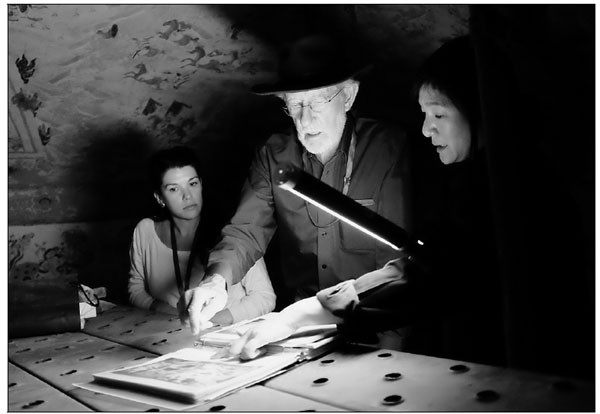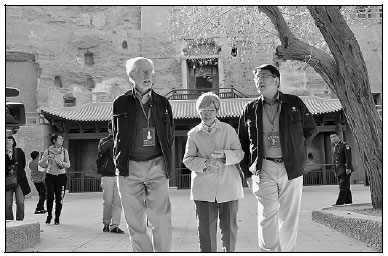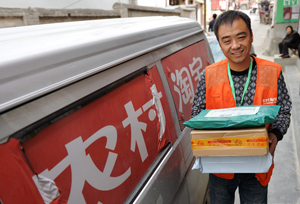Mogao Grottoes
The US conservationist devotes to restoring relics in NW China
Updated: 2015-10-23By Liu Xiangrui ( China Daily )
A heritage conservationist from the US has been working on a Dunhuang cave for decades, with happy results, Liu Xiangrui reports.
When he first visited the Mogao Grottoes in 1989, Neville Agnew didn't expect the site near Northwest China's Gobi desert to become his regular haunt.
A specialist in the conservation of relics, Agnew has been going to the caves filled with Buddhist statues in Gansu province, as part of a long-term engagement between his US employer and the Dunhuang Academy to work on guarding the UNESCO World Heritage site against decay and human effects.
"I didn't know much about the country," Agnew, 77, says of his early days in Dunhuang city. He works as the principal project specialist with Los Angeles-based Getty Conservation Institute.
The Mogao Grottoes that were a cultural stop on the ancient Silk Road flourished between the 4th and 14th centuries and comprise 492 caves with Buddhist wall paintings and sculptures.
Agnew's main focus is the conservation of wall paintings in Cave 85, a late Tang Dynasty (AD 618-907) gem, which has deteriorated due to salts from the underlying rocks.
He also works on the management of visitors, whose numbers have increased rapidly since the site was opened in 1979.
"The most striking thing for me is to imagine how it was like in ancient times, when businesspeople traveled along the Silk Road and overcame hardships and even dangers," he says, lost in thought. "Then monks took them into the caves. For them it was going to be a huge transformation from the desert environment. They had to be amazed."
Agnew recalls the site being an isolated place in the 1990s.
During one of the trips back then, he and his colleagues rode an overnight bus to the nearest airport in the provincial capital Lanzhou, which is more than 1,000 kilometers from Dunhuang.
A sandstorm had led to the local airport being shut down, but they were in a hurry to catch their flight back to the United States from Beijing.
Their bus moved along the mountain road, which had been the scene of many accidents.
"We've seen lots of improvement in many aspects over the years," Agnew says of the place.
He has also faced challenges while working in Dunhuang, but of a technical nature, he says.
The stories about him and Fan Jinshi, a former director of the Dunhuang Academy, are known to many people from both organizations.
"We had (our) differences and we even quarreled with each other a lot," Agnew says, smiling.
"But we were honest with each other and knew that we wanted the same good results. Over time, we have developed strong mutual trust and (have) become very good friends."
Years of collaboration gave Chinese and US heritage preservationists a lot to be happy about. The project on Cave 85 also influenced other parts of China.
The Dunhuang Academy and Getty Conservation Institute participated in drafting the Principles for the Conservation of Heritage Sites in China, a set of national guidelines.
Besides being involved with protection of relics in China, Agnew has made efforts to promote the Mogao Grottoes and the Silk Road in the Western world.
He has written or compiled publications, arousing strong interest in the Mogao Grottoes both among museum audiences and professional researchers in the US and Europe. He is also a curator for a major exhibition on the Dunhuang grottoes to be held at the Getty Museum in Los Angeles in May 2016.
The exhibition, which celebrates more than 25 years of collaboration between Agnew's institute and the Dunhuang Academy, is the first large-scale display on the Mogao Grottoes in North America. It also includes replicas of three of the Buddhist cave temples that survive on-site today.
As one of the earliest foreign experts in the field in China, Agnew has worked on the Yungang Grottoes in Shanxi province and the Chengde Imperial Summer Resort in Hebei province.
In 2006, he received the Friendship Award, a top honor given by the central government to foreigners for their contribution to China's development.
Agnew says working in China has been rewarding for him personally, too.
"I have gained deeper understanding of the Chinese people and their culture."
Agnew, who holds a PhD in chemistry, taught the subject at universities in Africa and Australia earlier. Interested in nature and culture, he later became involved in museum work in Queensland, Australia.
Contact the writer at liuxiangrui@chinadaily.com.cn
|
Neville Agnew (center) has devoted himself to the conservation of the Mogao Grottoes in China for the past few decades. Provided To China Daily |
|
Neville Agnew has developed a friendship with his Chinese colleague Fan Jinshi (center). Liu Xiangrui / China Daily |




